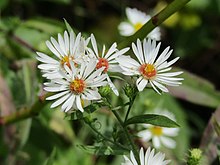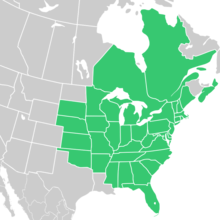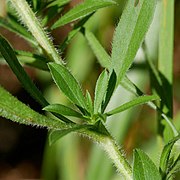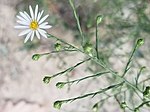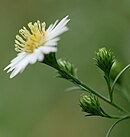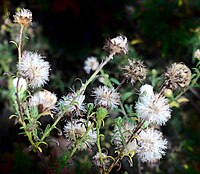
Symphyotrichum novae-angliae is a species of flowering plant in the aster family (Asteraceae) native to central and eastern North America. Commonly known as New England aster, hairy Michaelmas-daisy, or Michaelmas daisy, it is a perennial, herbaceous plant usually between 30 and 120 centimeters tall and 60 to 90 cm wide.
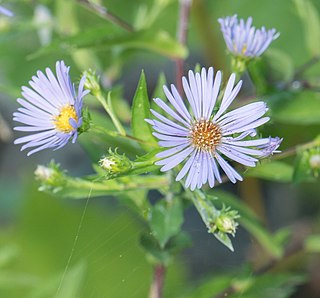
Symphyotrichum puniceum, is a species of flowering plant in the family Asteraceae native to eastern North America. It is commonly known as purplestem aster, red-stalk aster, red-stemmed aster, red-stem aster, and swamp aster. It also has been called early purple aster, cocash, swanweed, and meadow scabish.

Symphyotrichum ericoides, known as white heath aster, frost aster, or heath aster, is a species of flowering plant in the family Asteraceae native to much of central and eastern North America. It has been introduced to parts of Europe and western Asia.

Symphyotrichum laeve is a flowering plant native to Canada, the United States, and Coahuila (Mexico). It has the common names of smooth blue aster, smooth aster, smooth-leaved aster, glaucous Michaelmas-daisy and glaucous aster.

Symphyotrichum cordifolium, commonly known as common blue wood aster, heartleaf aster, and blue wood-aster, is a perennial herbaceous flowering plant in the family Asteraceae native to central and eastern North America. It reaches heights of up to 1.2 meters and has bluish daisy-like flowers which bloom late-summer and fall in its range.

Symphyotrichum lateriflorum is a species of flowering plant in the aster family (Asteraceae). Commonly known as calico aster, starved aster, and white woodland aster, it is native to eastern and central North America. It is a perennial and herbaceous plant that may reach heights up to 120 centimeters and widths up to 30 centimeters.

Symphyotrichum ascendens is a species of flowering plant in the family Asteraceae known by the common names western aster, long-leaved aster, and Rocky Mountain aster. Blooming July–September, it is native to western North America and can be found at elevations of 500–3,200 m (1,600–10,500 ft) in several habitats.

Symphyotrichum defoliatum is a species of flowering plant in the family Asteraceae known by the common name San Bernardino aster. It is endemic to Southern California where it grows in grasslands and meadows, and it is of conservation concern.

Symphyotrichum frondosum is a species of flowering plant in the family Asteraceae native to western North America. Commonly known as short-rayed alkali aster, it is an annual or perennial herbaceous plant that may reach 140 centimeters tall.

Symphyotrichum lanceolatum is a species of flowering plant in the family Asteraceae native to North America. Common names include panicled aster, lance-leaved aster, and white panicled aster. It is a perennial, herbaceous plant that may reach 1.5 meters tall or more, sometimes approaching 2 m. The lance-shaped leaves are generally hairless but may feel slightly rough to the touch on the top because of tiny bristles. The flowers grow in clusters and branch in panicles. They have 16–50 white ray florets that are up to 14 millimeters long and sometimes tinged pink or purple. The flower centers consist of disk florets that begin as yellow and become purple as they mature.

Symphyotrichum falcatum is a species of flowering plant in the family Asteraceae. Commonly called white prairie aster and western heath aster, it is native to a widespread area of central and western North America.
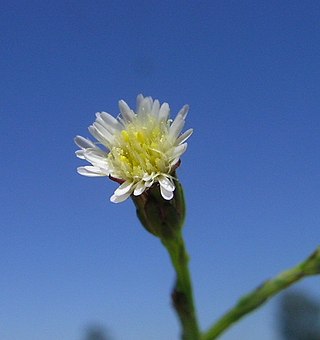
Symphyotrichum subulatum, commonly known as eastern annual saltmarsh aster or, in Britain and Ireland where it is naturalized, annual saltmarsh aster, is an annual plant in the family Asteraceae native to the eastern United States and the Gulf Coast to Texas. The species grows primarily in coastal salt marshes, although in the Ozarks it occurs as a non-marine weedy variety.
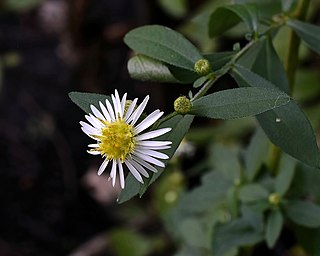
Symphyotrichum ontarionis is a species of flowering plant in the family Asteraceae native to eastern North America. Commonly known as Ontario aster and bottomland aster, it is a perennial, herbaceous plant that may reach heights of 120 centimeters. Each flower head has many tiny florets put together into what appear as one.

Symphyotrichum racemosum is a species of flowering plant native to parts of the United States and introduced in Canada. It is known as smooth white oldfield aster and small white aster. It is a perennial, herbaceous plant in the family Asteraceae. It is a late-summer and fall blooming flower.
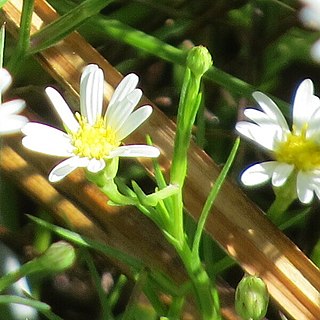
Symphyotrichum potosinum is a species of flowering plant in the family Asteraceae native to Mexico and the U.S. state of Arizona. Commonly known as Santa Rita Mountain aster, it is a perennial, herbaceous plant that may reach heights of 15 to 45 centimeters.

Symphyotrichum molle is a species of flowering plant in the aster family (Asteraceae) endemic to the Bighorn Mountains of Montana and Wyoming in the United States. Commonly known as soft aster, it is a perennial, herbaceous plant that ranges from 30 to 60 centimeters in height.
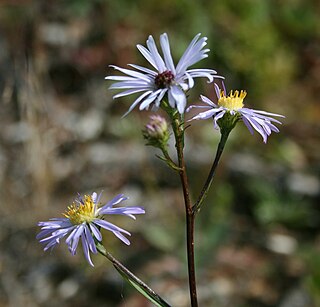
Symphyotrichum foliaceum is a species of flowering plant in the family Asteraceae native to western North America. Commonly known as leafy aster, leafy-bracted aster, and alpine leafybract aster, it is a perennial, herbaceous plant that may reach 10 to 60 centimeters in height. Its flowers have violet to purple ray florets and yellow disk florets. Four varieties were accepted as of July 2021 by Plants of the World Online (POWO), as follows: S. foliaceum var. apricum, S. foliaceum var. canbyi, S. foliaceum var. cusickii, and S. foliaceum var. parryi. The autonym is S. foliaceum var. foliaceum.

Symphyotrichum spathulatum is a species of flowering plant in the family Asteraceae native to western North America including northwestern Mexico. Commonly known as western mountain aster, it is a perennial, herbaceous plant that may reach 20 to 80 centimeters tall. Its flowers, which open in July and August, have violet ray florets and yellow disk florets.

Symphyotrichum divaricatum is an annual and herbaceous plant commonly known as southern annual saltmarsh aster. It is native to the southern United States and some northern states of Mexico.

Symphyotrichum kentuckiense is a rare species of flowering plant in the Asteraceae family and is commonly known as Kentucky aster, Price's aster, Miss Price's aster, Sadie's aster, or lavender oldfield aster. It is a perennial, herbaceous plant that is endemic to broken limestone cedar glades and roadsides in Alabama, Georgia, Kentucky, and Tennessee. It blooms from August through October, reaches heights between 30 centimeters and 100 cm (3.3 ft), and has green to reddish-brown stems. It is a nearly hairless plant with blue to blue-violet ray florets.
